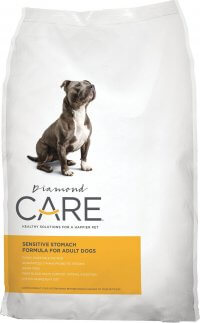
DogFoodAdvisor is reader supported See how
All reviews are 100% impartial but if you buy using links on this page, we may earn a referral fee.
Our Verdict
Diamond Care Dog Food product range is made up of four recipes, three of which receive the Dog Food Advisor’s rating, 4 stars.
Please note: One of the recipes is not rated, this is because the criteria we use to rate foods is designed for foods which support the everyday feeding of healthy dogs. Foods which are designed for a particular nutritional purpose or veterinary condition can contain ingredients or nutritional values which align with a lower rating, but are necessary and appropriate in formulas which tackle certain issues or concerns. Despite the reserved rating, this is a great example of a weight management and joint support diet which is highly recommended.
The table below shows each recipe in this range including our rating and the AAFCO nutrient profile: Growth (puppy), Maintenance (adult), All Life Stages, Supplemental or Unspecified.
| Product line | Rating | AAFCO |
|---|---|---|
| Diamond Care Rx Renal Formula Adult | Not Rated | M |
| Diamond Care Sensitive Skin Formula Adult | 4 | M |
| Diamond Care Sensitive Stomach Formula Adult | 4 | M |
| Diamond Care Weight Management Formula Adult | 4 | M |
Recipe and Label Analysis
Diamond Care Sensitive Stomach Formula was selected to represent the other products in the line for detailed recipe and nutrient analysis.
Diamond Care Sensitive Stomach Formula
Estimated Dry Matter Nutrient Content
Protein
Fat
CarbsCarbohydrates
Potatoes, egg product, potato protein, tomato pomace, chicken fat (preserved with mixed tocopherols), flaxseed, natural flavor, menhaden fish oil, dicalcium phosphate, calcium carbonate, psyllium seed husk, ginger, dried chicory root, choline chloride, taurine, dried lactobacillus plantarum fermentation product, dried bacillus subtilis fermentation product, dried lactobacillus acidophilus fermentation product, dried enterococcus faecium fermentation product, dried bifidobacterium animalis fermentation product, vitamin E supplement, iron proteinate, zinc proteinate, copper proteinate, ferrous sulfate, zinc sulfate, manganese sulfate, copper sulfate, potassium iodide, thiamine mononitrate, manganese proteinate, ascorbic acid, vitamin A supplement, biotin, niacin, calcium pantothenate, sodium selenite, pyridoxine hydrochloride, vitamin B12 supplement, riboflavin, vitamin D3 supplement, folic acid
Fiber (estimated dry matter content) = 3%
Red denotes any controversial items
| Estimated Nutrient Content | |||
|---|---|---|---|
| Method | Protein | Fat | Carbs |
| Guaranteed Analysis | 25% | 13% | NA |
| Dry Matter Basis | 28% | 14% | 50% |
| Calorie Weighted Basis | 25% | 31% | 44% |
Ingredients Analysis
The first ingredient in this dog food lists potato. Potatoes can be considered a gluten-free source of digestible carbohydrates. Yet with the exception of perhaps their caloric content, potatoes are of only modest nutritional value to a dog.
The second ingredient is egg product, an unspecified (wet or dry?) form of shell-free eggs. Quality can vary significantly. Lower grade egg product can even come from commercial hatcheries — from eggs that have failed to hatch.
In any case, eggs are easy to digest and have an exceptionally high biological value.
The third item is potato protein, the dry residue remaining after removing the starchy part of a potato.
Even though it contains over 80% protein, this ingredient would be expected to have a lower biological value than meat.
And less costly plant-based products like this can notably boost the total protein reported on the label — a factor that must be considered when judging the actual meat content of this dog food.
The next ingredient is tomato pomace. Tomato pomace is a controversial ingredient, a by-product remaining after processing tomatoes into juice, soup and ketchup.
Many praise tomato pomace for its high fiber and nutrient content, while others scorn it as an inexpensive pet food filler.
Just the same, there’s probably not enough tomato pomace here to make much of a difference.
The fifth ingredient is chicken fat. This item is obtained from rendering chicken, a process similar to making soup in which the fat itself is skimmed from the surface of the liquid.
Chicken fat is high in linoleic acid, an omega-6 fatty acid essential for life. Although it doesn’t sound very appetizing, chicken fat is actually a quality ingredient.
Next, we find flaxseed, one of the best plant sources of healthy omega-3 fatty acids. Provided they’ve first been ground into a meal, flax seeds are also rich in soluble fiber.
However, flaxseed contains about 19% protein, a factor that must be considered when judging the actual meat content of this dog food.
After the natural flavor, we find menhaden oil. Menhaden are small ocean fish related to herring. Their oil is naturally rich in the prized EPA and DHA type of omega-3 fatty acids, two high quality fats boasting the highest bio-availability to both dogs and humans.
What’s more, in their mid-depth habitat, menhaden are not as likely to be exposed to mercury contamination as is typical with deep water species.
From here, the list goes on to include a number of other items.
But to be realistic, ingredients located this far down the list (other than nutritional supplements) are not likely to affect the overall rating of this Diamond product.
With four notable exceptions…
First, we find chicory root. Chicory is rich in inulin, a starch-like compound made up of repeating units of carbohydrates and found in certain roots and tubers.
Not only is inulin a natural source of soluble dietary fiber, it’s also a prebiotic used to promote the growth of healthy bacteria in a dog’s digestive tract.
Next, we note the use of taurine, an important amino acid associated with the healthy function of heart muscle. Although taurine is not typically considered essential in canines, some dogs have been shown to be deficient in this critical nutrient.
Since taurine deficiency appears to be more common in pets consuming grain-free diets, we view its presence in this recipe as a positive addition.
In addition, this recipe contains sodium selenite, a controversial form of the mineral selenium. Sodium selenite appears to be nutritionally inferior to the more natural source of selenium found in selenium yeast.
And lastly, this food includes chelated minerals, minerals that have been chemically attached to protein. This makes them easier to absorb. Chelated minerals are usually found in better dog foods.
Nutrient Analysis
Based on its ingredients alone, Diamond Care Sensitive Stomach Formula Adult looks like an above-average dry product.
The dashboard displays a dry matter protein reading of 28%, a fat level of 14% and estimated carbohydrates of about 50%.
Excluding the Diamond RX formula, the brand features an average protein content of 26% and a mean fat level of 12%. Together, these figures suggest a carbohydrate content of 55% for the overall product line.
And a fat-to-protein ratio of about 52%.
Above-average protein. Below-average fat. And near-average carbs when compared to other dry dog foods.
When you consider the protein-boosting effect of the potato protein and flaxseed, this looks like the profile of a recipe containing a notable amount of meat.
Diamond Dog Food Recall History
The following automated list (if present) includes all dog food recalls related to Diamond through December 2025.
You can view a complete list of all dog food recalls since 2009 here.
Our Rating of Diamond Care Grain-Free Dog Food
Diamond Care is a special purpose, grain-free dry dog food using at least a moderate amount of named meat or egg as its dominant source of animal protein, thus earning the brand 4 stars.
Compare Diamond Care Dog Food
How does Diamond Care compare with The Dog Food Advisor's most recommended brands?
A Final Word
The Dog Food Advisor does not accept money, gifts, samples or other incentives in exchange for special consideration in preparing our reviews.
However, we do receive a referral fee from online retailers (like Chewy or Amazon) and from sellers of perishable pet food when readers click over to their websites from ours. This helps cover the cost of operation of our free blog. Thanks for your support.
For more information, please visit our Disclaimer and Disclosure page.








